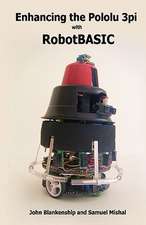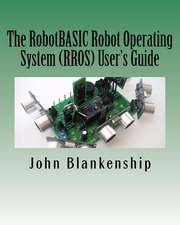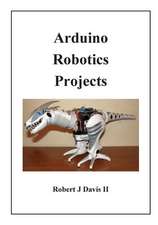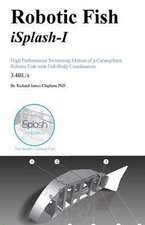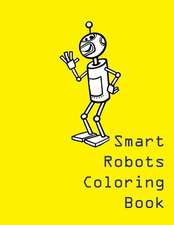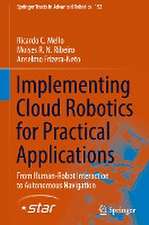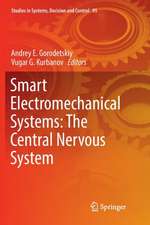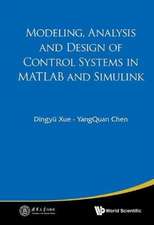Optical Fiber Sensors for the Next Generation of Rehabilitation Robotics
Autor Arnaldo Leal-Junior, Anselmo Frizera-Netoen Limba Engleză Paperback – 2 noi 2021
This book will be a great resource for mechanical, electrical and electronics engineers and photonics and optical sensing engineers.
- Addresses optical fiber sensing solutions in wearable systems and soft robotics
- Presents developments—from foundational, to novel and future applications—of optical fiber sensors in the next generation of robotic devices
- Provides methods for the instrumentation of novel compliant devices
Preț: 567.49 lei
Nou
108.62€ • 118.03$ • 91.30£
Carte disponibilă
Livrare economică 31 martie-14 aprilie
Livrare express 14-20 martie pentru 33.77 lei
Specificații
ISBN-10: 0323859526
Pagini: 316
Ilustrații: Approx. 110 illustrations
Dimensiuni: 152 x 229 x 34 mm
Greutate: 0.42 kg
Editura: ELSEVIER SCIENCE
Public țintă
Undergraduate and graduate level electronic engineers, mechanical engineers, mechatronic engineers, photonic engineers and biomedical engineers.R&D Professionals in healthcare devices, robotics and materials development
Cuprins
Preface ix
Part I
Introduction to soft robotics and rehabilitation systems
1. Introduction and overview of wearable technologies
1.1 Motivation 3
1.2 Wearable robotics and assistive devices 10
1.3 Wearable sensors and monitoring devices 14
1.4 Outline of the book 18
References 21
2. Soft wearable robots
2.1 Soft robots: definitions and (bio)medical applications 27
2.2 Soft robots for rehabilitation and functional compensation 30
2.3 Human-in-the-loop design of soft structures and healthcare systems 34
2.3.1 Human-in-the-loop systems 34
2.3.2 Human-in-the-loop applications and current trends 37
2.3.3 Human-in-the-loop design in soft wearable robots 39
2.4 Current trends and future approaches in wearable soft robots 43
References 46
3. Gait analysis: overview, trends, and challenges
3.1 Human gait 53
3.2 Gait cycle: definitions and phases 56
3.2.1 Kinematics and dynamics of human gait 57
3.3 Gait analysis systems: fixed systems and wearable sensors 58
References 61
Part II
Introduction to optical fiber sensing
4. Optical fiber fundaments and overview
4.1 Historical perspective 67
4.2 Light propagation in optical waveguides 69
4.3 Optical fiber properties and types 72
4.4 Passive and active components in optical fiber systems 76
4.4.1 Light sources 77
4.4.2 Photodetectors 77
4.4.3 Optical couplers 79
4.4.4 Optical circulators 80
4.4.5 Spectrometers and optical spectrum analyzers 81
4.5 Optical fiber fabrication and connection methods 83
4.5.1 Fabrication methods 84
4.5.2 Optical fiber connectorization approaches 87
References 89
5. Optical fiber materials
5.1 Optically transparent materials 93
5.2 Viscoelasticity overview 96
5.3 Dynamic mechanical analysis in polymer optical fibers 101
5.3.1 DMA on PMMA solid core POF 103
5.3.2 Dynamic characterization of CYTOP fibers 107
5.4 Influence of optical fiber treatments on polymer properties 111
References 115
6. Optical fiber sensing technologies
6.1 Intensity variation sensors 119
6.1.1 Macrobending sensors 120
6.1.2 Light coupling-based sensors 125
6.1.3 Multiplexed intensity variation sensors 127
6.2 Interferometers 129
6.3 Gratings-based sensors 133
6.4 Compensation techniques and cross-sensitivity mitigation in optical fiber sensors 138
References 143
Part III
Optical fiber sensors in rehabilitation systems
7. Wearable robots instrumentation
7.1 Optical fiber sensors on exoskeleton’s instrumentation 151
7.2 Exoskeleton’s angle assessment applications with intensity variation sensors 152
7.2.1 Case study: active lower limb orthosis for rehabilitation
(ALLOR) 156
7.2.2 Case study: modular exoskeleton 157
7.3 Human-robot interaction forces assessment with Fiber Bragg
Gratings 160
7.4 Interaction forces and microclimate assessment with intensity variation sensors 166
References 172
8. Smart structures and textiles for gait analysis
8.1 Optical fiber sensors for kinematic parameters assessment 175
8.1.1 Intensity variation-based sensors for joint angle
assessment 175
8.1.2 Fiber Bragg gratings sensors with tunable filter
interrogation for joint angle assessment 178
8.2 Instrumented insole for plantar pressure distribution and ground reaction forces evaluation 183
8.2.1 Fiber Bragg grating insoles 183
8.2.2 Multiplexed intensity variation-based sensors for smart
insoles 188
8.3 Spatiotemporal parameters estimation using integrated optical fiber sensors 198
References 199
9. Soft robotics and compliant actuators instrumentation
9.1 Series elastic actuators instrumentation 201
9.1.1 Torque measurement with intensity variation sensors 202
9.1.2 Torque measurement with intensity variation sensors 206
9.2 Tendon-driven actuators instrumentation 212
9.2.1 Artificial tendon instrumentation with highly flexible
optical fibers 213
References 217
Part IV
Case studies and additional applications
10. Wearable multifunctional smart textiles
10.1 Optical fiber embedded-textiles for physiological parameters monitoring 223
10.1.1 Breath and heart rates monitoring 224
10.1.2 Body temperature assessment 232
10.2 Smart textile for multiparameter sensing and activities monitoring 234
10.3 Optical fiber-embedded smart clothing for mechanical perturbation and physical interaction detection 239
References 241
11. Smart walker’s instrumentation and development with compliant optical fiber sensors
11.1 Smart walkers’ technology overview 245
11.2 Smart walker embedded sensors for physiological parameters assessment 247
11.2.1 System description 247
11.2.2 Preliminary validation 250
11.2.3 Experimental validation 252
11.3 Multiparameter quasidistributed sensing in a smart walker structure 252
11.3.1 Experimental validation 252
11.3.2 Experimental validation 256
References 260
12. Optical fiber sensors applications for human health
12.1 Robotic surgery 263
12.2 Biosensors 269
12.2.1 Introduction to biosensing 269
12.2.2 Background on optical fiber biosensing working
principles 271
12.2.3 Biofunctionalization strategies for fiber immunosensors 276
12.2.4 Immunosensing applications in medical biomarkers
detection 279
References 282
13. Conclusions and outlook
13.1 Summary 287
13.2 Final remarks and outlook 290
Index 293
Descriere
Optical Fiber Sensors for the Next Generation of Rehabilitation Robotics presents development concepts and applications of optical fiber sensors made of compliant materials in rehabilitation robotics. The book provides methods for the instrumentation of novel compliant devices. It presents the development, characterization and application of optical fiber sensors in robotics, ranging from conventional robots with rigid structures to novel wearable systems with soft structures, including smart textiles and intelligent structures for healthcare. Readers can look to this book for help in designing robotic structures for different applications, including problem-solving tactics in soft robotics.
This book will be a great resource for mechanical, electrical and electronics engineers and photonics and optical sensing engineers.
- Addresses optical fiber sensing solutions in wearable systems and soft robotics
- Presents developments—from foundational, to novel and future applications—of optical fiber sensors in the next generation of robotic devices
- Provides methods for the instrumentation of novel compliant devices









